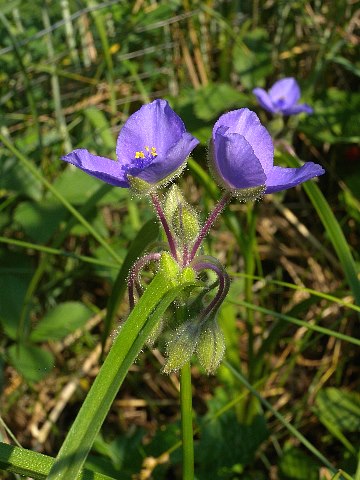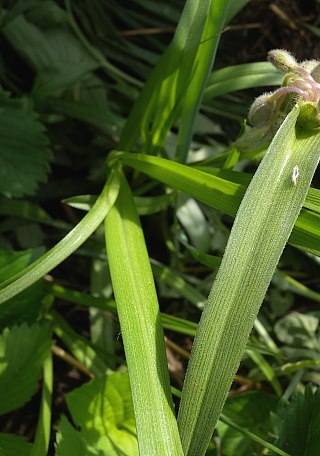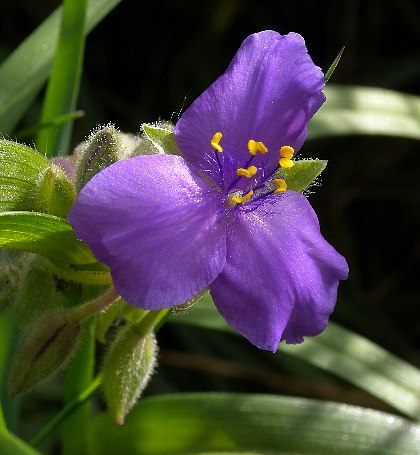Description: This perennial wildflower is ½-1½' tall. The erect central stem is light to medium green, terete, glabrous, and usually unbranched. Sheathed leaves with long floppy blades alternate along this stem. The leaf blades are 4-12" long and up to ¾" across; they are medium green, linear-lanceolate, parallel-veined, and mostly glabrous, except for occasional hairs where the blades emerge from the sheaths. The sheaths are glabrous with parallel veins; sometimes they have purple veins.

The central stem terminates in an umbel-like cyme of flowers and a pair of large leafy bracts. These bracts have the same characteristics as the alternate leaves, and they are similar in size. The slender pedicels of the flowers are about ½-1" in length; they are light green to purple, glandular-hairy, and rather floppy. Individual flowers are 1-1¼" across, consisting of 3 blue-violet or rose petals, 3 light green sepals with glandular-hairy exteriors, 6 stamens with hairy filaments and yellow anthers, and a pistil. The sepals are lanceolate-ovate, while the petals are ovate-oval; the petals are a little longer than the sepals. The blooming period occurs from late spring to mid-summer and lasts about 1½ months. Usually, only 1-2 flowers are in bloom at the same time. The flowers are usually open only in the morning, except on cloudy days, when they may remain open a little longer. Each flower lasts only a single day and there is no noticeable fragrance. The flowers are replaced by seed capsules about ¼" long that are 3-celled; they are oblongoid-ovoid or oblongoid-obovoid in shape. Eventually, each seed capsule splits open into 3 parts, releasing 2-6 seeds. The seeds are about 2-3 mm. in length, tan or gray, broadly oblongoid, and somewhat flattened; each seed has a heavily ridged outer margin and it is indented along one side with a point in the middle. The root system is fibrous and rhizomatous. This wildflower often spreads vegetatively by means of its rhizomes, forming colonies.

Cultivation:
The preference is full sun, dry-mesic conditions, and sandy soil,
although it readily adapts to other kinds of soil. On fertile ground,
competition from taller plants is poorly tolerated.
Range & Habitat:
The native Prairie Spiderwort is an uncommon plant that is found
primarily in west-central Illinois (see Distribution
Map). It is state-listed as 'threatened.' It is more common
in areas further to the west. Habitats include upland sand prairies,
hill prairies, barren areas along railroads, and roadside embankments.
This wildflower can be found in both disturbed and high quality natural
areas, especially where it is sandy.
Faunal Associations:
The flowers offer only pollen as a reward to insect visitors. These
floral visitors include honeybees, bumblebees, Halictid bees, and
Syrphid flies. However, most Syrphid flies are too small to be
effective at cross-pollination. The foliage, and sometimes the flowers,
of Tradescantia spp. are eaten by such leaf beetles
as Lema collaris, Lema longipennis,
Oulema cornuta, and Oulema elongata.
In sandy habitats, Spharagemon collare (Mottled
Sand Grasshopper) also feeds on Prairie Spiderwort. The non-toxic
foliage is readily eaten by rabbits and other mammalian herbivores.

Photographic Location: The photographs were taken at the webmaster's wildflower garden in Urbana, Illinois.
Comments: Other common names of Tradescantia bracteata are Long-Bracted Spiderwort and Sticky Spiderwort. Prairie Spiderwort can be distinguished from other Tradescantia spp. in Illinois by its diminutive size (1½' tall or less) and the glandular hairs on its sepals and pedicels. The most similar species in Illinois is Virginia Spiderwort (Tradescantia virginiensis). Virginia Spiderwort is slightly taller 1-2½' than Prairie Spiderwort, and the hairs on its sepals and pedicels are glandless. Another species in this genus, Ohio Spiderwort (Tradescantia ohiensis), lacks hair on its sepals and pedicels, its foliage is more blue-gray, and it is significantly taller (2-3' tall).